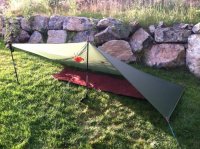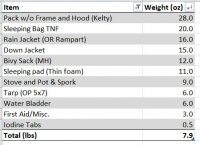- Joined
- Jan 4, 2015
- Messages
- 2,901
I'm going to have to thank @mak1277 and @LarryBoy for pointing out the Tarptent Double Rainbow and Six Moon Designs Wild Oasis respectively. Looks like both brands have some other great offerings as well. I've now added both to my growing gear wishlist in addition to the Tarptent ProTrail. The Double Rainbow looks like it would be great for excursions with my wife or any of my children. The Tarptent ProTrail looks quite sturdy, yet lightweight and versatile for a full coverage shelter system for one. When I'm sleeping solo, I don't mind a front loader.
If you or @steve is interested, I can post a review of the Wild Oasis. Taking the Gatewood Cape on its maiden voyage this weekend (although standards are different for poncho-tarps than they are for standard tarps), so it'll take some time to evaluate how it works for me.
First impressions for me is that the Gatewood Cape in shelter mode is actually better than the Wild Oasis. The ventilation will be better, the supplied guy line is more user-friendly, the entire left side of the shelter can be opened up on nice nights, and there's an internal pocket to stash your sunglasses in a safe place during the night. The only real advantage that the Wild Oasis has is that it's got a bug skirt around the perimeter.
Oh and with regards to alcohol stoves -
I used a fantastic design for about four months of everyday use with zero complaints. It was relatively fast, quiet, efficient, and reliable. It was a "penny stove" design and, although it needed a separate pot stand (wire coat hanger), it was a well-engineered piece of equipment. The only time I had difficulty cooking was in early March in the Appalachians, when it was so cold that my Bic lighter refused to work! Unfortunately, it was lost when I moved out west.
Conversely, its replacement was a stove made out of a cat food can with holes punched in the side. I hate it. It has a tendency to leak fuel, is very suceptible to wind gusts, uses way too much fuel, and offers slow boil times. The only reason I haven't junked it yet is because I don't really use stoves anymore. I'm too lazy to clean my cookpot!
In summary, my experience with alky stoves has gone both ways. I'd say I've learned a couple things -
- Design matters. My penny stove was pressurized, self-regulating of flame rate, efficient, and aesthetically pleasing. My supercat stove was crap.
- Craftsmanship matters even more. I cut the pop cans with a razor saw, used a tiny drill bit for the jets, used a protractor to ensure even hole spacing, sealed the joints with JB-Weld, and sanded down irregularities. Measure twice, cut once. Yes, you're making a project out of stuff you'd find in the recycle bin, but if you do a good job and take pride in it, your stove will serve you much better. I'm no handyman, but simply taking the time and doing it right yields great results.
- Practice! Build 5 or 6 to hone your skills, and give away the early attempts to friends! Just make sure you're not consuming 5 or 6 beers while making your 5 or 6 beer can stoves!


